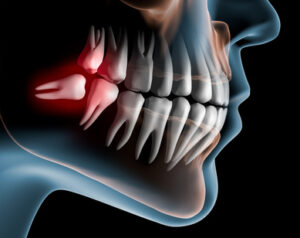Book a dental appointment
Extraction of an impacted wisdom tooth
Extraction of an impacted wisdom tooth
Humans have usually four wisdom teeth that are the posterior molars in the upper and lower jaw and complete formation in adulthood. The period of erupting of wisdom teeth is very individual. They generally appear between the ages of 17 and 25, for some much later and for some they do not break through the jaw and soft tissues at all. In over 75% of people wisdom teeth do not fit on the line of occlusion, 90% of people has at least one partially erupted or an impacted wisdom tooth that may cause problems in the future.
The removal of each wisdom tooth is decided on an individual basis.

Is wisdom tooth surgery really necessary?
Removal of a wisdom tooth is decided individually. An examination of the oral cavity, a panorama/3-D X-ray and answers to the following questions give a good overview of the situation:
- Can the wisdom tooth be used for replacing of an extracted or damaged molar?
- Have the wisdom teeth already caused pathological changes in the jawbones or they can be expected to occur?
- Is the development and erupting of the wisdom teeth normal?
- Are various complications possible during surgery?
When a 3-D X-ray is necessary?
A 3-D X-ray is necessary to consider the risks of surgery if the wisdom teeth have serious development anomaly, are close to a sensory nerve canal or the maxillary sinus, when roots have unclear shape and pathological changes in the bone can be detected. An X-ray is also necessary to see formation of roots in case of a wisdom tooth transplantation.
What are the risks if the development and eruption of the wisdom teeth is not normal?
- If the wisdom tooth lies on an adjacent tooth, it puts pressure on it during eruption and may damage its root, the surrounding bone or cause defects in dentition.
- Partially erupted teeth become inflamed in 50% of cases and in some cases may cause severe abscesses.
- There is a risk of formation of cysts that cause jawbone defects that may lead to a fractured jawbone.
- Resorption of roots (dissolution of tooth roots).
- Pain with unknown cause that may often move to the ear. The patient experiences it as uncomfortable earache.
- Cheek mucosa trauma that may lead to formation of leukoplakia (a white spot) that may, although rarely, turn into a malignant cancer.
- Cleaning of wisdom teeth is often difficult that causes caries that may spread to an adjacent tooth.
Risks of a wisdom tooth extraction:
In addition to usual complications of surgery, such as bleeding and inflammation, some specific complications may occur:
- A sensory malfunction and numbness of lower teeth, lips, tongue and mucosa because the lower wisdom tooth sits between two sensory nerves. These malfunctions are very rarely permanent.
- Extraction of inflamed wisdom teeth may cause bone inflammation or an abscess, very rarely maxillary sinusitis (especially if upper teeth were removed).
- In very rare cases, the lower jawbone may fracture.
Extraction of wisdom teeth is necessary if:
- the wisdom teeth have caries that cannot be treated with conventional methods and their roots are infected (a complex and often impassable root canal system and limited access);
- there are cysts;
- there are bone changes;
- orthodontic treatment indicates removal of the wisdom teeth;
- adjacent teeth are damaged;
- wisdom teeth cause occlusion malfunction, pain, mucosa trauma and inflammation.
Wisdom tooth surgery should not be undertaken if:
- the wisdom tooth has erupted in a correct position and participates in the chewing process;
- removal of another molar is planned that is intended to be replaced with the wisdom tooth (orthodontic shifting of teeth and tooth transplantation);
- the wisdom tooth sits deep in the bone, does not have any pathology and its removal would be very traumatic and risky;
- the patient has a grave mental illness that does not allow the procedure to be conducted by giving a local anaesthetic in an ambulatory setting (a general anaesthetic is indicated).
Wisdom tooth surgery:
- Wisdom tooth surgery may be easy, yet sometimes difficult and with complications.
- This is an ambulatory procedure that is performed with a local anaesthetic. One tooth or two teeth are allowed to be removed from one side of the mouth at one time.
- During surgery, if necessary, the bone around the tooth is removed and the tooth is split up with a drill. Small root pieces may be left in the bone only if their removal is too risky and may cause nerve damage. After extraction of the tooth, the wound is checked, cleaned and, if necessary, an antiseptic or haemostatic gauze pad is placed on the wound and then the wound is sutured. The stitches are removed after 7–10 days.
In case of a traumatic operation, if the tooth is inflamed or the patient suffers from systemic general diseases, a course of antibiotics treatment is indicated. If you have any further questions about extraction of a wisdom tooth or this procedure, please feel free to contact us at 5335 99 66.
Read more about our other dental treatment services here.
Read more about extraction of an impacted wisdom tooth here.
